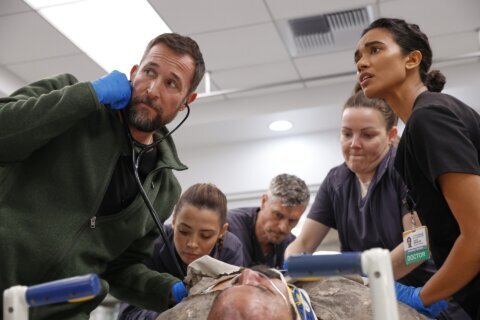Hear our full chat on my podcast “Beyond the Fame with Jason Fraley.”
His 2017 Broadway smash, “The Band’s Visit,” won a whopping 10 Tony Awards, including Best Musical.
On Tuesday night, playwright Itamar Moses staged the world premiere of “An American Tail: The Musical” at Children’s Theatre Company in Minneapolis, Minnesota, with dreams of someday bringing it to D.C.
“Especially with a musical based on such a well-known and beloved film, there are certainly ambitions to move beyond Minneapolis to go to other cities, including (D.C.), a major theater city and major city for America’s tradition of politics and immigration — D.C. would be the perfect place to do this show,” Moses said. “Nothing is set in stone yet, but that is certainly our intention to take it everywhere. D.C. is a great theater town. It really is.”
Born in Berkeley, California in 1977, Moses grew up a fan of Don Bluth’s 1986 animated flick.
“I was nine years old when the movie came out, so if that’s not the exact target age for that movie, it’s close,” Moses said. “I remembered the movie from when I was a kid. I probably hadn’t seen it in 30 years, but some of those songs were still in my head — and of course Fievel’s iconic hat — so I was like, ‘Yeah, sign me up.’ They reached out to me and asked if I wanted to do the adaptation, and I jumped at the chance.”
The film arrived as Walt Disney Animation was nearly bankrupted by “The Black Cauldron” (1985), allowing Bluth to compete with “An American Tail” (1986), “The Land Before Time” (1988) and “All Dogs Go to Heaven” (1989). Even as Disney recovered with “The Little Mermaid” (1989), “Beauty and the Beast” (1991), “Aladdin” (1992) and “The Lion King” (1994), Bluth cranked out alternative hits from “Thumbelina” (1994) to “Anastasia” (1997).
“Don Bluth was an animator at Disney, but he wanted to do different types of stories that were a little darker or edgier — I mean, they’re cartoons for kids, they’re not Tarantino — but just to go to a darker, artsy place that isn’t quite the Disney brand. So he broke away and started doing his own thing,” Moses said. “There’s a scene (where Fievel) is in the middle of an Irish wake and the mouse who’s dead on the table is a mouse named Mickey.”
Set in 1885 Russia, the story follows the Mousekewitzes, a family of Russian-Jewish mice who flee their village when it’s attacked by cats (i.e. the Cossacks). They flee on an immigrant ship to America, but when young Fievel accidentally falls overboard, he swims to shore to New York City to search for his family, who thinks he’s dead.
“His sidekick, the Artful Dodger to his Oliver, is Tony Toponi, the street-wise Italian mouse; a protest-organizing revolutionary mouse named Bridget, Honest John, who runs the mouse equivalent of Tammany Hall; there’s Warren T. Rat, a shady mafioso-type character who does some underworld dealings; and Henri, a French pigeon who’s building a famous statue that will one day stand on a little island off the coast of Manhattan,” Moses said.
To bring these characters to life, the costume designer creates anthropomorphic animals similar to Broadway’s “The Lion King,” while the scenic designers craft larger-than-life objects to make the actors appear small like mice.
“You can play around a lot with scale,” Moses said. “You just build these human objects at enormous size (like) when Bridget stands on a soapbox, she’s literally standing on a giant box for one bar of soap. … Obviously in a cartoon you can put anything on screen that you can imagine — you just draw it — but you have very different limitations on stage, so it’s a great challenge and opportunity for the designers. The magic of theater is illusion.”
Best of all, the songbook maintains a few key songs from the movie while adding a series of original numbers by songwriting duo Michael Mahler and Alan Schmuckler, including “Set You Free” for a chorus of cockroaches.
“The movie only has four songs, and the two that people tend to remember are ‘Somewhere Out There’ and ‘No Cats in America,'” Moses said. “Even if we used all four, that’s not really enough for a full stage musical, so we knew right off the bat that we were going to have to write six, seven, eight more songs. In the end, we used three songs from the movie and wrote a bunch of new ones to give it the frequency of song that you need for a stage musical.”
Moses has prior experience adapting films to the stage as “The Band’s Visit” actually began as a 2007 Israeli film by Eran Kolirin, who was skeptical about letting Moses turn it into a musical with new songs by David Yazbek.
“The Israeli filmmaker said ‘no’ the first few times,” Moses said. “He didn’t grant the rights because he didn’t really know anything about musicals. He said something like, ‘You know, I thought it was a bad idea because the only musical I know is ‘Cats’ and I thought, so what, he’s going to dress them as cats?'”
Don’t worry, Fievel, there are no cats in “The Band’s Visit.”
Hear our full chat on my podcast “Beyond the Fame with Jason Fraley.”








